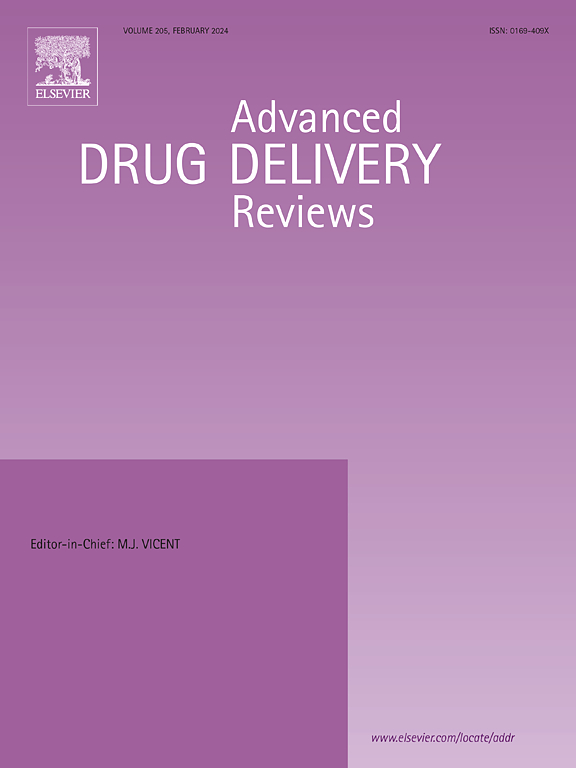Modulating the electronic structure of graphdiyne-based nanomaterials for engineering nano-bio interfaces in biomedical applications
IF 17.6
1区 医学
Q1 PHARMACOLOGY & PHARMACY
引用次数: 0
Abstract
Graphdiyne (GDY), a two-dimensional (2D) carbon allotrope featuring a unique electronic structure, has attracted considerable attention due to its outstanding properties and potential applications in various fields, particularly in biomedicine due to its exceptional surface area, tunable electronic structure, and biocompatibility. Although promising, this field is still in the proof-of-concept stage due to incomplete understanding of the effects of structural regulation, particularly electronic structure, of GDY-based nanomaterials on their nano-bio interfaces, which seriously hinders the research of GDY-based nanomaterials in the biomedical field. To provide a comprehensive understanding of the relationship between electronic structures and nano-bio interfaces, this review focuses on the modulation of the electronic structure of GDY-based nanomaterials and its implications for engineering nano-bio interfaces for biomedical applications. Firstly, we delve into the intrinsic electronic properties of GDY, including its bandgap tunability and high carrier mobility, which are critical for its functionality in biomedical applications. We then discuss strategies for modulating these properties through oxidation, nonmetallic doping, covalent modification, and metal loading, aiming to optimize the electronic structure of GDY-based nanomaterials for superior performance in specific biomedical contexts, such as biomedical imaging, surface and interface catalysis, free radical scavenging, and drug delivery. Furthermore, we provide an overview of the methodologies for the investigation of these electronic properties, including theoretical simulation, characterization techniques, and real-time analysis of electron transfer at the nano-bio interfaces, highlighting their roles in advancing our understanding and guiding the design of novel GDY-based materials. Finally, this review provides an outlook on future research directions aimed at further optimizing the design of GDY-based nanomaterials and nano-bio interfaces, emphasizing the need for interdisciplinary collaboration to overcome current challenges and to fully realize the potential of GDY-based nanomaterials in biomedical applications. These principles are anticipated to facilitate the future development and clinical translation of precise, safe, and effective nanomedicines with intelligent theranostic features.


调节石墨烯基纳米材料的电子结构,用于生物医学应用中的工程纳米生物界面
石墨炔(Graphdiyne, GDY)是一种具有独特电子结构的二维(2D)碳同素异形体,由于其优异的性能和在各个领域,特别是生物医学领域的潜在应用(基于其优异的表面积,可调谐的电子结构和生物相容性)而受到广泛关注。虽然前景广阔,但由于对gdd基纳米材料的结构调节,特别是电子结构对其纳米生物界面的影响的认识不完全,这严重阻碍了gdd基纳米材料在生物医学领域的研究,因此该领域仍处于概念验证阶段。为了全面了解电子结构与纳米生物界面之间的关系,本文重点介绍了基于gdd的纳米材料的电子结构调制及其对生物医学应用的工程纳米生物界面的影响。首先,我们深入研究了GDY的固有电子特性,包括其带隙可调性和高载流子迁移率,这对其在生物医学应用中的功能至关重要。然后,我们讨论了通过氧化、非金属掺杂、共价修饰和金属负载来调节这些特性的策略,旨在优化基于gdd的纳米材料的电子结构,以在特定的生物医学环境中获得卓越的性能,如生物医学成像、表面和界面催化、自由基清除和药物输送。此外,我们还概述了研究这些电子特性的方法,包括理论模拟、表征技术和纳米生物界面上电子转移的实时分析,强调了它们在促进我们理解和指导新型gdd基材料设计中的作用。最后,展望了未来的研究方向,旨在进一步优化gdd基纳米材料和纳米生物界面的设计,强调需要跨学科合作来克服当前的挑战,充分发挥gdd基纳米材料在生物医学领域的应用潜力。这些原则有望促进具有智能治疗功能的精确、安全、有效的纳米药物的未来发展和临床转化。
本文章由计算机程序翻译,如有差异,请以英文原文为准。
求助全文
约1分钟内获得全文
求助全文
来源期刊
CiteScore
28.10
自引率
5.00%
发文量
294
审稿时长
15.1 weeks
期刊介绍:
The aim of the Journal is to provide a forum for the critical analysis of advanced drug and gene delivery systems and their applications in human and veterinary medicine. The Journal has a broad scope, covering the key issues for effective drug and gene delivery, from administration to site-specific delivery.
In general, the Journal publishes review articles in a Theme Issue format. Each Theme Issue provides a comprehensive and critical examination of current and emerging research on the design and development of advanced drug and gene delivery systems and their application to experimental and clinical therapeutics. The goal is to illustrate the pivotal role of a multidisciplinary approach to modern drug delivery, encompassing the application of sound biological and physicochemical principles to the engineering of drug delivery systems to meet the therapeutic need at hand. Importantly the Editorial Team of ADDR asks that the authors effectively window the extensive volume of literature, pick the important contributions and explain their importance, produce a forward looking identification of the challenges facing the field and produce a Conclusions section with expert recommendations to address the issues.

 求助内容:
求助内容: 应助结果提醒方式:
应助结果提醒方式:


